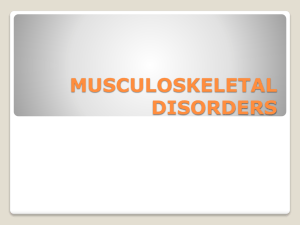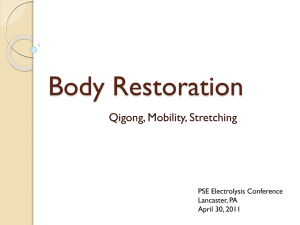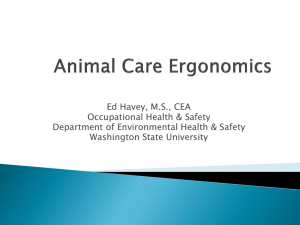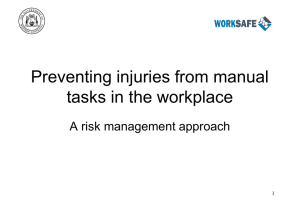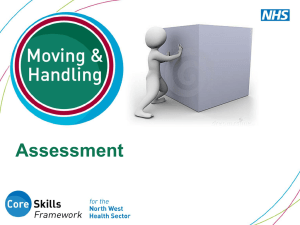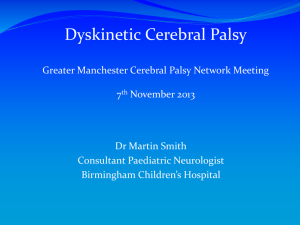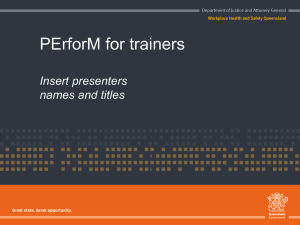Ergonomics Awareness Education - Environmental Health & Safety
advertisement
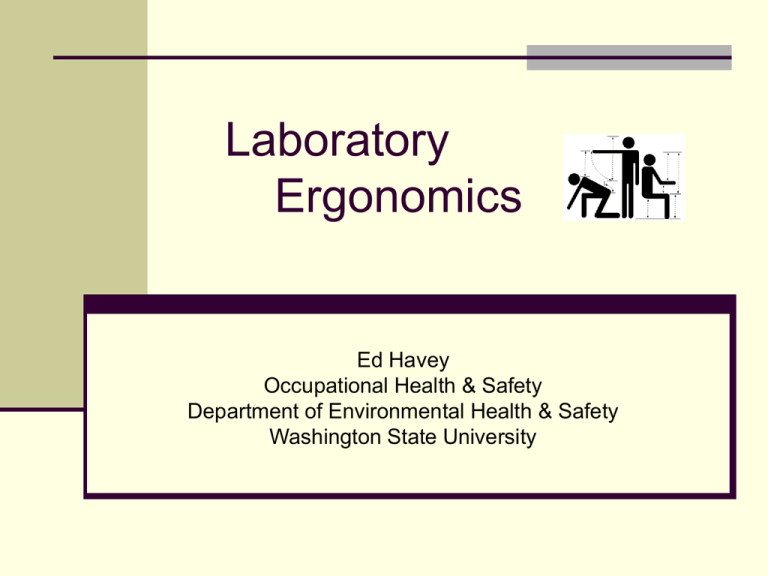
Laboratory Ergonomics Ed Havey Occupational Health & Safety Department of Environmental Health & Safety Washington State University Ergonomics Ergonomics is the science and practice of designing tasks and workplaces considering our capabilities and limitations. OR Fitting the work to the person User Equipment/Work Space Tasks Benefits of Ergonomics Prevention of Work-Related Musculoskeletal Disorders (WMSD) Reduced fatigue and discomfort Increased productivity Improved quality of work What are Work-Related Musculoskeletal Disorders? WMSDs are soft-tissue injuries to muscles, tendons, ligaments, cartilage, blood vessels and nerves that usually develop gradually. Also know as: Cumulative Trauma Disorders (CTDs) Neurovascular Disorders Repetitive Strain Injuries (RSIs) Overuse Injuries Common WMSDs WMSDs occur in the moving body parts like the neck, back, shoulders, elbows, wrists, fingers and knees. Low Back Injury Carpal Tunnel Syndrome Tendonitis Tenosynovitis Epicondylitis De Quervain’s Syndrome WMSDs Symptoms Discomfort/Pain Numbness/Tingling Swelling Burning Sensations Loss of range of motion Shooting/Stabbing Stiffness or tight muscles Pains Weakness or clumsiness in the hands; dropping things Hands or feet feel like they are falling “asleep” Having one or more symptom does not mean you have a WMSD What Causes WMSDs? WMSDs can develop when demand exceeds capacity. Exposure (intensity, frequency and duration) to the following risk factors or combination of risk factors might lead to a WMSD: Awkward and Static Postures Highly Repetitive Motions High Hand Force Contact Stress Vibration Cold Temperatures Lighting WMSD Prevention & Treatment Preventing and responding to WMSDs involves: Designing or modifying the work environment Task variability User health/fitness Professional Health Care Laboratory Design Good design minimizes awkward and static postures by allowing the user to: Sit/stand in neutral postures Frequently change postures Locate equipment and materials based on use Good design = Desired postures & motions Task Variability Task variability offers several advantages: Opportunity to change postures Different tasks can use different muscle groups Provides recovery time and pauses for stretches Tasks with highly repetitive motions and high hand forces can be spread out throughout the work day Users will be cognitively more alert and productive Common Laboratory Activities Pipetting Microscopy Microtome Work Fume Hoods/Biological Safety Cabinets Micro-Manipulation & Fine Motor Skills Standing Work Computer Work Lifting Pipetting Associated Risk Factors: Repetitive motions – hands, forearm and thumb Pinch grips – handling tips and vials Bending & twisting of the wrist “Winged” elbows Neck bent forward or to the side and/or jutted chin Excessive force of the thumb Pipetting Preventative Measures: Electronic or latch-mode pipette instead of manual plunger Use thin-walled tips that are easy to eject Limit periods of continuous pipetting to 20 minutes (2 minute micro-breaks) Adjust height/position of sample holders, containers, waste receptacles to assure neutral postures Ensure proper back and thigh support by using adjustable stools or chairs with foot and arm rests Microscopy Associated Risk Factors: Awkward and static posture of the neck & back Lack of leg/knee clearance under work table Eye strain & fatigue Wrist & arm contact stress Pinch grip when making adjustments “Winged” elbows Microscopy Preventative Measures: Extended eye tube and/or variable height adapter Adjust eyepiece’s height to allow head and neck neutral posture Position microscope close to the user Avoid arm and wrist contact pressure (pad sharp & hard edges) Ensure feet are flat on the floor or use a foot rest Reduce repetition motion and prolonged awkward postures by taking micro-breaks Microscopy Microtome Work Associated Risk Factors: Highly repetitive functions Force of turning wheel Awkward and static postures of the arms, back, neck Contact stress of the forearms and wrists Microtome Work Preventative Measures: Place microtome at appropriate height based on user Use chair/stool with adjustable arm and foot rest Protect wrist and forearms from contact stress by padding sharp & hard edges Use less force when turning hand wheel Take micro-breaks Replace manual rotary microtome with an automatic one Fume Hoods/Biological Safety Cabinets Associated Risk Factors: Repetitive motions of the hands and wrists Constrained knee and leg space in fume hoods and older BSC Awkward and static postures of the neck, torso, legs, arms and wrists Contact stress on the forearms, wrists and knees and/or legs Working with “winged” elbows Eye strain Fume Hoods/Biological Safety Cabinets Preventative Measures: Position materials as close as possible to avoid extended reaching (at least 6” back for fume hood) Avoid contact stress – apply foam padding Reduce eyestrain and awkward postures by keeping viewing window of hood/BSC and line of sight unobstructed Make sure hood/BSC lighting is working properly Use a ergo-task chair or stool with foot rest Take micro-breaks Micro-Manipulation & Fine Motor Skills Associated Risk Factors: Repetitive motion Force Awkward postures Contact Stress Micro-Manipulation & Fine Motor Skills Preventative Measures: Use plastic vials with fewer threads to reduce twisting motions during capping and uncapping lids Use small pieces of foam where fingers and forceps articulate Practice using forceps between first and second digits Tilt storage bins towards workers Take micro-breaks Standing Work Associated Risk Factors: Static Postures Awkward Postures – neck, head and arms Associated Health Concerns: Sore feet Swelling of the legs Fatigue Low back pain Neck pain Standing Work Preventative Measures: Proper shoes Change in posture Walking Footrests Sit-stand stools Anti-fatigue mats Computer Workstation Ergonomics Computer workstation ergonomic considerations: User Workstation configuration Chair Desk & Keyboard/Mouse Tray Input Devices Monitor – CRT vs. LCD Tasks Office lighting Lifting Risk Factors: Health & injury history Lifting, carrying, pulling & pushing Awkward & static postures Object weight Preventative Measures: Neutral postures Fitness Shorten lever arms Minimize weight Proper lifting technique Questions and Consultation If you have additional questions or would like to schedule an ergonomic evaluation contact: Ed Havey havey@wsu.edu or 5-5311
